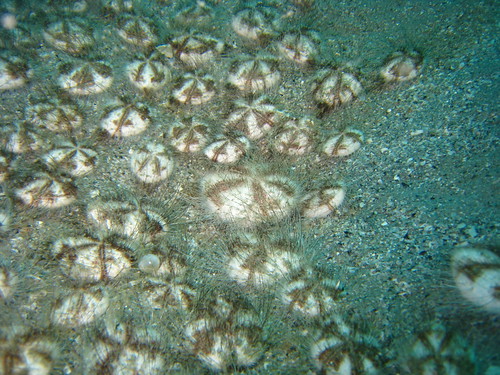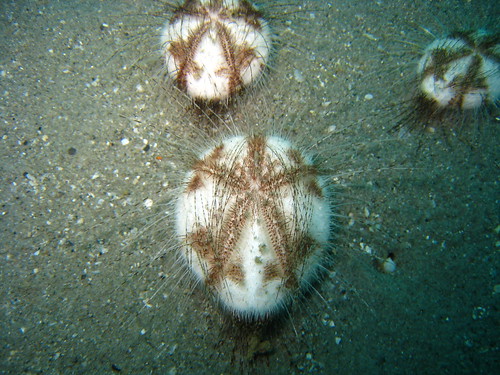Every once in awhile, I think that I might finally have run out of stuff to share with people and THEN something magic happens. Some fantastic new video or pic pops up and WOO! The diversity of echinoderms and the infinite resourcefulness of the Internet pop out of nowhere with some magic NEW biology to share!!
Case in point is this video, which was shot by "Dive Yos" showing various cool inverts spotted during a dive in Bali. The video was posted 2 months ago...
It starts with a few typical things, a sea anemone, sea horses, etc. a lot of typical fare...but then we see one, two, four heart urchins, six... and then at 0:27 into the video? BOOOM!!! You got this HUGE heart urchin stampede!!!
Best as I can tell, these are the heart urchin, Maretia planulata, described by Lamarck in 1816. This species of urchin lives throughout the tropical Indo-Pacific, from Tanazania to the Marshall islands...
They live in relatively shallow water on the surface of sandy bottoms.
Here's what one individually looks like.
Heart urchins are "irregular urchins" which are closely related to sand dollars. I wrote up a post on a related animal called Echinocardium, which you can find here.

But WOW! What is going on with this HUGE aggregation??
Here's a Flickr shot from 2008
As I've written before, other "regular" urchins sometimes form "urchin barrens" when the ecological balance of a particular region is out of whack and you have TOO many of them eating EVERYTHING in sight...
But the thing is, Maretia is a heart urchin (aka a spatangoid). They are sediment feeders, so they don't really eat kelp. I suppose the absence of some predator might be the cause. And the huge numbers could STILL deplete food in a given region, but this high abundance seems to be a regular thing.
There are other websites which have also observed that they occur in high numbers like this... Such as this one displaying this aggregation.
 |
| Photo by Geoffrey Bertrand, on his website |
I would love to know more about whatever is going on here. Or maybe this will be the beginning of someone's Phd thesis? Don't know. But the thought of 100s (thousands?) of these things galloping along the bottom of the Indo-Pacific sandy bottoms is just... farking AMAZING!


11 comments:
Are those heart urchins related to this hilarious little guy?
https://www.youtube.com/watch?v=FWZv0SZCDiw
Yes. WOW! look at that thing go!!
Awesome!
And yeah, I had no idea they could book like that.
I'm almost a little disappointed you didn't already have our speedy little friend in here! ;)
Thank you so much for that video! Truly amazing.
Unfortunately, when I do my searches..even I am surprised what does and does not turn up. It amazes me why I miss things like the video you showed me, but I guess their search engines have a different thing in mind...
thanks again!
I have an urchin anatomy question. I found this video https://www.youtube.com/watch?v=D4mBdi1CiW4
at about 1:17 there is a purple urchin that has an inflatable "siphon". What is that and what is the animal doing?
On a related note stars have skin pallilae and cucumbers bring in water through their anus. What do urchins do to ventilate/respire? Do they have skin pallilae or rely on their podia or madroporite?
The structure you are seeing is an unusual feature specific to urchins in the family Diadematidae, called an Anal Cone. Its basically an extended sac for food to be excreted from the intestine. I've written a bit about it with pictures here:
http://echinoblog.blogspot.com/2012/06/follow-up-on-anal-cone-thanks-to-new.html
And yes.. all urchins have papulae (gills) which emerge through the urchin's surface and permit respiration of gases in a manner similar to how starfish and sea cucumbers respire..
thanks for your question!
Thanks!
Have you seen this? What is going on? https://www.facebook.com/TELEGRAPH.CO.UK/videos/10153258144984749/?fref=nf
Yes. apparently a big mating aggregation.
hello Chris, greetings from Miag-ao, Iloilo (Philippines). Yesterday I saw 3 heart urchins, dead and floating in the surf zone. I've been to that beach many times and I've never seen them before. Do you think this is also Maretia planulata? https://drive.google.com/file/d/1QPYq7xohz-UwVTWLkk9MhB6rudip-Qt-/view?usp=sharing
I wonder if what I saw is the aftermath of a mating aggregation... hmmm... I shoulda gone to check, but the water was also full of jellyfish yesterday!
thank you! It does look like Maretia! interesting!
Post a Comment